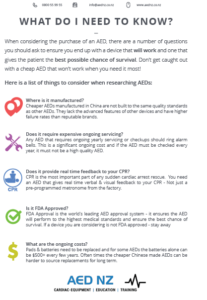
When it comes to Automated External Defibrillators (AEDs), having one is only half the battle. Equally important is where you place the device. In emergencies, time is critical—quick access to an AED can make the difference between life and death. In this blog post, we’ll explore the importance of strategic AED placement and provide tips for determining the best locations in homes, workplaces, and public spaces.
Why Placement Matters
In cases of sudden cardiac arrest (SCA), survival rates drop by 10% for every minute that passes without defibrillation. While emergency services aim to respond as quickly as possible, having an easily accessible AED can significantly increase the chances of survival. Poorly placed or hard-to-find AEDs can delay treatment, reducing their life-saving potential.
AED Placement in Homes
While it may seem unusual to have an AED at home, households with individuals at higher risk of cardiac arrest—such as those with heart conditions or a family history of heart disease—should seriously consider it. Here’s where to place it:
- Centralized Location: Place the AED in a common area, such as the living room or kitchen, where it is easily accessible to everyone in the house.
- Near High-Risk Individuals: If a family member has a known heart condition, consider placing the AED near their bedroom or living space.
- Avoid Hidden Storage: Don’t store your AED in closets or drawers—it should be mounted on a wall or placed in a visible cabinet with clear signage.
AED Placement in Workplaces
Workplaces are common sites for AEDs, but improper placement can render them ineffective during emergencies. Consider the following:
- High-Traffic Areas: Place AEDs in locations where employees and visitors frequently pass, such as reception areas, break rooms, or hallways.
- Near Potential Hazards: For industrial sites or high-risk workplaces, position AEDs near areas where accidents or physical exertion are more likely.
- Centralized for Large Spaces: In larger buildings or office complexes, ensure there are enough AEDs to cover all areas. Aim for an AED to be reachable within 1–3 minutes from any location.
- Compliance with Safety Standards: Ensure placement complies with New Zealand workplace safety regulations, which may include signage and proper mounting height.
AED Placement in Public Spaces
Public access AEDs are becoming increasingly common, especially in busy locations where cardiac emergencies are more likely to occur. Here’s where they should go:
- Sporting Venues: Cardiac emergencies can happen during intense physical activity. Ensure AEDs are located near locker rooms, spectator areas, or playing fields.
- Transport Hubs: Airports, bus stations, and train stations should have AEDs clearly visible in central areas, such as terminals or ticketing zones.
- Shopping Centres: Place AEDs in high-traffic areas like food courts or main entrances where they’re easily visible to shoppers and staff.
- Outdoor Spaces: Parks, hiking trails, and beaches can benefit from AEDs in weatherproof cabinets near entrances, pavilions, or lifeguard stations.
Key Tips for Effective AED Placement
- Visibility: Use bright, standardized signage to indicate AED locations. Signs should be visible from a distance and meet international AED symbol guidelines.
- Accessibility: AEDs should be accessible to all individuals, including those with disabilities. Avoid placing devices behind locked doors or in areas with restricted access.
- Regular Maintenance: Once placed, regularly check AEDs to ensure they’re functional. Verify that pads and batteries are within their expiration dates and that the device is ready to use.
Making AEDs Accessible Saves Lives
Strategic AED placement is essential to maximizing the device’s life-saving potential. Whether at home, in the workplace, or in public spaces, AEDs should be placed thoughtfully to ensure they are easily accessible during an emergency.
If you’re ready to invest in an AED for your home, workplace, or community, browse our range of devices at www.aednz.co.nz. Our team can help you select the right AED and provide guidance on proper placement and maintenance, so you’re prepared to save a life when it matters most.
We recommend the ZOLL AED Plus Defibrillator:
-
Compliant with New Zealand Resuscitation Council Guidelines
-
FDA Approved
-
ECG monitoring capability built into every device
-
Lowest cost of ownership
-
No yearly servicing plans or ongoing maintenance required
-
5 Year battery & pad life
-
7 Year Warranty
-
IP55 Rated
-
Made in USA





